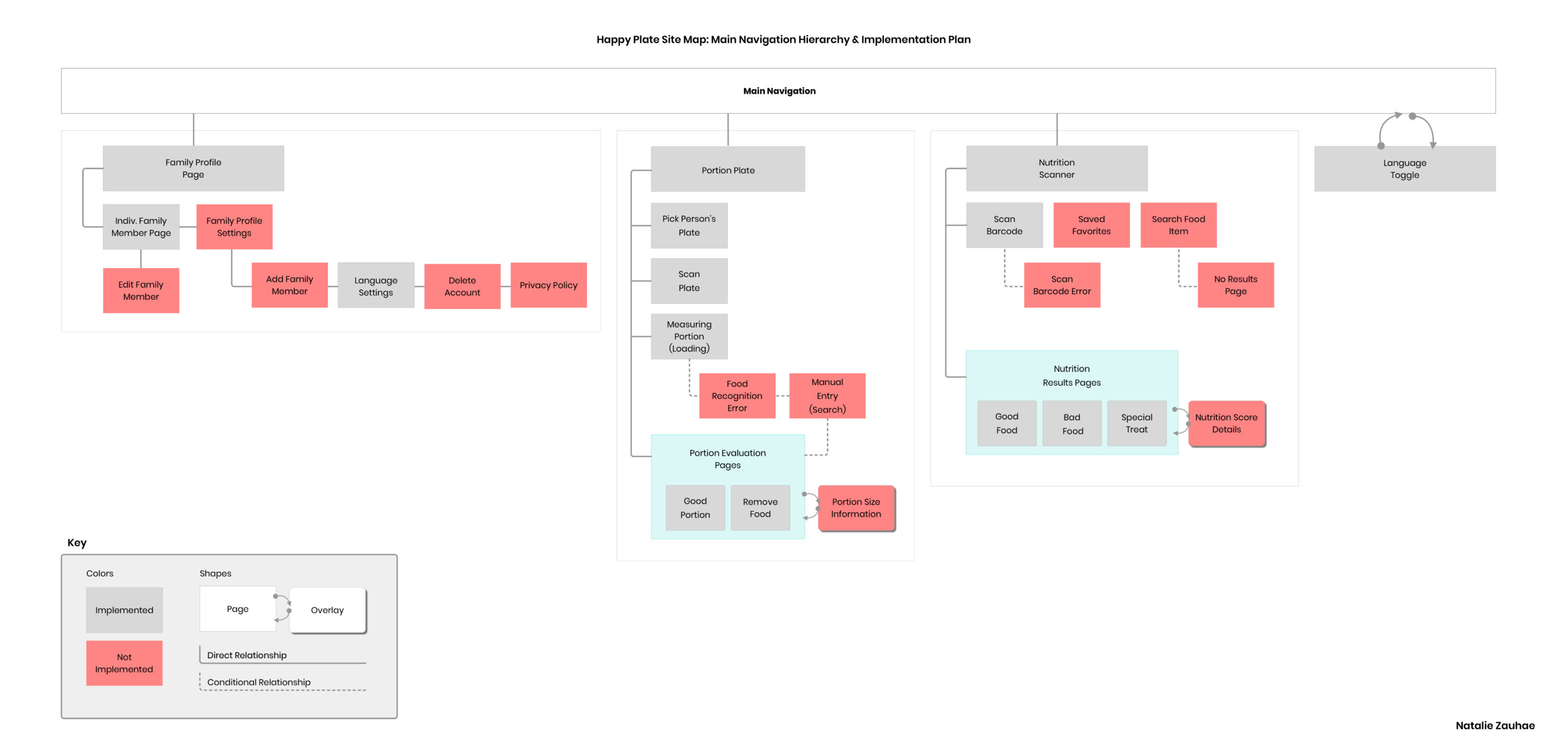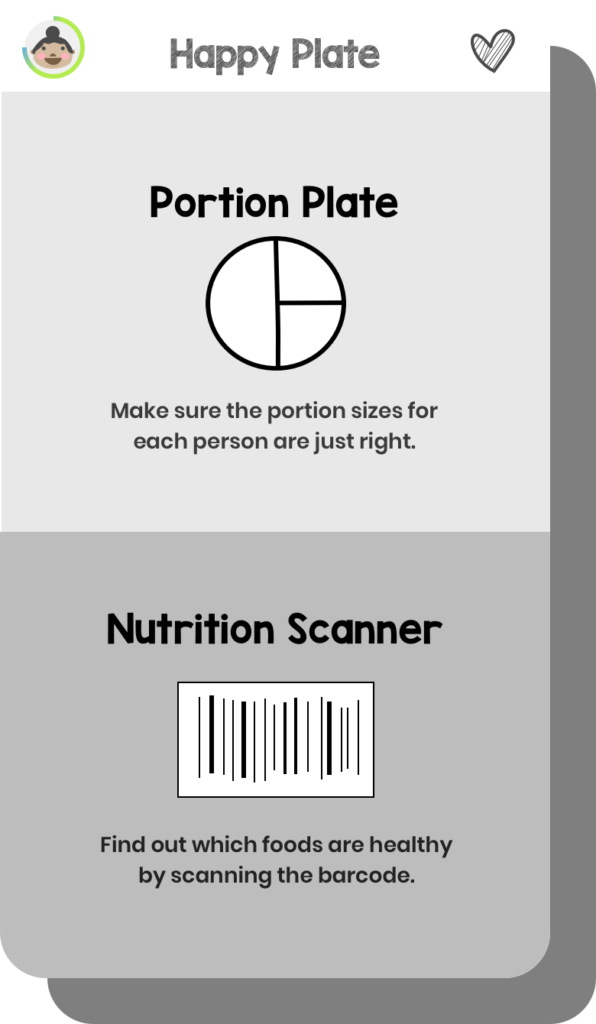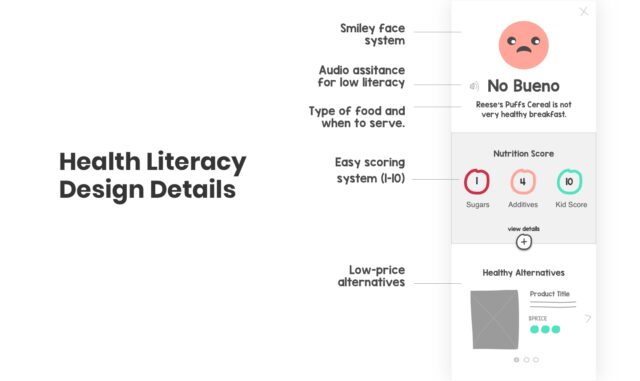Happy Plate
A bilingual health literacy app for the whole family.
Methods & Tools
- Literature Review
- Competitor Analysis
- Storyboards
- Personas
- Paper Prototyping
- User Testing
- Wireframing–Sketch
- Prototyping–Figma
13.7 million children in the United States are affected by childhood obesity— How might we help overcome childhood obesity?
Project Overview
During three months, I challenged myself to find an interactive design solution to help mitigate this epidemic. Education, poverty, environment, and culture are commonly cited factors contributing to childhood obesity; though, the issue transcends socioeconomic class, education, and culture.
From my background research, I found low health literacy in families to be the strongest predictor of childhood obesity. The CDC also reported low socioeconomic status families, and Hispanic families are at the highest risk. My project focused on increasing health literacy to promote healthy eating behaviors for these vulnerable groups.

How does health literacy affect childhood obesity?
Risk Factors
Families with low health literacy are at the highest risk for developing childhood obesity.
According to the National Action Plan to Improve Health Literacy, groups that are more likely to have limited health literacy include “adults 65 years old, non-white individuals, recent refugees and immigrants, people without a high school degree or General Education Diploma, people living at or below the poverty level, and non-native English speakers” [8].
Barriers to Health Literacy
1. Poor Comprehension 90 million Americans have basic or below literacy skills which could result in a poor understanding of health information leading to poor health behaviors [3].
2. Poor Quantitative Skills 110 million American adults have basic or poor numeracy skills which could lead to difficulty understanding and calculating nutritional content & portion sizes [3].
3. Cultural Differences Limited awareness of cultural differences can lead poor health outcomes due to poor understanding. For example, miscommunication between the translation of languages or understanding of word meaning. There could also be cultural perceptions for what is considered a healthy weight.
4. Parents & Caregivers Positive health outcomes for children are reliant upon parents and caregivers to have and teach health literacy skills. Below is a conceptual model relating parent health literacy to child outcomes.

Target Audience
I focused on the group of people at the highest risk of developing childhood obesity: children who have parents with limited health literacy.
These families have children between the ages of 2-19 years old in the United States, live in poverty, have low literacy and numeracy skills, and do not speak English fluenty (either poor English literacy or English is not their native language). Their low health literacy specifically concerns little to no knowledge about proper nutrition and portion sizes. Adults and children ages seven and up will be the direct users of this application; children under six years old will benefit indirectly.
Also, this particular design is focused on bilingual Hispanic families. Research has shown there is a cultural perception among the Hispanic communities that “moderately overweight” Hispanic children appear to be healthier [9]. Therefore, this design solution helps create “positive eating behaviors” and does not focus on the child’s weight [9].
Preliminary Personas
Competitor Analysis
Competitor Analysis Insight
There is a need to make health information more accessibility to bilingual families.
Methodology
I used journal articles to identify my competitors, of which I only selected ones with scientific evidence proving to be effective for preventing and helping overcome childhood obesity. I focused on the following three: Kurbo, SlipBuddy, and Change4Life Food Scanner. I also evaluated FigWee, a portion control app, since I found that portion control can have the most significant impact on one’s diet, and the other apps did not focus on educating users about portion sizes.
View the competitor analysis report here.

Design Solution
A bilingual health literacy app for the whole family.
I designed this application to be a simple and easy-to-use smartphone app for families to use to help improve their health literacy. The goal of this app is to help families build healthier eating behaviors by making nutritional information easier to understand. It features a nutrition scanner to quickly learn about nutritional information in an easily digestible format and a simple portion size checker that provides custom recommendations for each family member.
Additionally, this solution was designed for the entire family to use and optimized for device sharing in the home (for low-income families). There are also enhanced accessibility features to support varying levels of literacy and language proficiency in the home (including children) like voice assistant options (to assist low literacy skills) and support for bilingual translations.
View the final report here.
Information Architecture

User feedback on my paper prototype allowed the design to evolve more.

Original Homepage Design
A focus on simplicity that was too simple

Revised Homepage
Visible navigation to enhance accessibility
Through prototype testing, I was able to find several improvements to the user interface and new features for the Happy Plate application. The biggest area of improvement needed was within the Portion Size Checker feature. My participants also suggested features I had not considered to improve adherence to the application as an intervention and what information should be collected from users.
Read the detailed paper prototype report here and view paper prototype video here.
A pediatrician’s advice for improvements
During the profile setup flow, the pediatrician I spoke with suggested additional data collection I had not thought to include. They recommended I ask for the parent’s height and weight to help project what the growth expectations might be for their children. I implemented this feature to help estimate the growing child’s dietary needs.
The pediatrician also suggested I include how often the food item should be served and to allow for “Special Treats” since not all unhealthy food is “bad” as long as it is in moderation.
A more accessible navigation
The transition from paper prototype into Sketch illuminated the need for a navigation overhaul. When I thought through how users would navigate back and forth, I found the navigation design was too simple and could not sustain any added interactions without causing trouble navigating between pages. This change resulted in the homepage changing to the Family Profile page and a new always-on bottom drawer navigation.
Furthermore, the always-on navigation would be more accessible to children or users like children who have difficulty with memory or abstract concepts.
During this phase, I also focused on creating increased accessibility through the user interface design and added features like the language preference toggle.

Final Design Solution
Figma Design Assets & Prototype
The final design of how Happy Plate functions is outlined in this report. To view the design work, the digital assets in Figma are here or use the embedded prototype. The prototype shows the following ordered tasks:
- Language Setup
- Family Setup (Parent & Child)
- Portion Checker
- Nutrition Scanner (Good, Bad, Special Treat)
- Language Toggle
Next Steps
Further Research
Before launching this application, further research should be conducted to optimize the design for the following research questions:
- What type of information should be shown to users to help improve health literacy?
- Would users like to check the portion size for food by barcode?
- What gamification tactics could be used to keep family engaged?
- How might data be collected for the kid scoring system?
- Do users want to share updates with other family/community members? (e.g., Abuela?)
Continued Implementation
To complete the application, the following will need to be implemented. You can also reference the site map (highlighted in red).
- Family setting pages which includes recent activity and other advanced settings
- Informational overlays within the Nutrition Scanner and Portion Size Checker features
- Saved favorites page and interactions within the Nutrition Scanner feature
- Error states and unknown edge cases
- Search functionality and interactions.
References
- “Childhood Obesity Facts.” Centers for Disease Control and Prevention. Centers for Disease Control and Prevention, June 24, 2019. https://www.cdc.gov/obesity/data/childhood.html.
- “Childhood Overweight and Obesity.” Centers for Disease Control and Prevention. Centers for Disease Control and Prevention, September 11, 2018. https://www.cdc.gov/obesity/childhood/index.html.
- Delamater, Perrin, Rothman, Sanders, and Yin. “Role of Parent Health Literacy in Early Child Obesity and Other Health Outcomes.” Grantome. NIH, December 1, 2014. http://grantome.com/grant/NIH/R01-HD059794-07.
- “Health Literacy.” Health Literacy | Healthy People 2020. https://www.healthypeople.gov/2020/topics-objectives/topic/social-determinants-health/interventions-resources/health-literacy.
- “Let’s Move!” Wikipedia. Wikimedia Foundation, December 16, 2019. https://en.wikipedia.org/wiki/Let’s_Move!
- Marks, Ray. “Childhood Obesity and Parental Health Literacy.” Medcraveonline.com. MedCrave, October 14, 2015. http://medcraveonline.com/AOWMC/AOWMC-03-00055.pdf.
- National Action Plan to Improve Health Literacy. https://health.gov/communication/initiatives/health-literacy-action-plan.asp.
- “National Action Plan to Improve Health Literacy.” Health Literacy Studies. Harvard, July 31, 2019. https://cdn1.sph.harvard.edu/wp-content/uploads/sites/135/2012/09/national_action_plan_to_improve_health_literacy.pdf.
- Pulgarón, Elizabeth R, Anna Maria Patiño-Fernández, Janine Sanchez, Adriana Carrillo, and Alan M Delamater. “Hispanic Children and the Obesity Epidemic: Exploring the Role of Abuelas.” Families, systems & health : the journal of collaborative family healthcare. U.S. National Library of Medicine, September 2013. https://www.ncbi.nlm.nih.gov/pmc/articles/PMC3963701/












